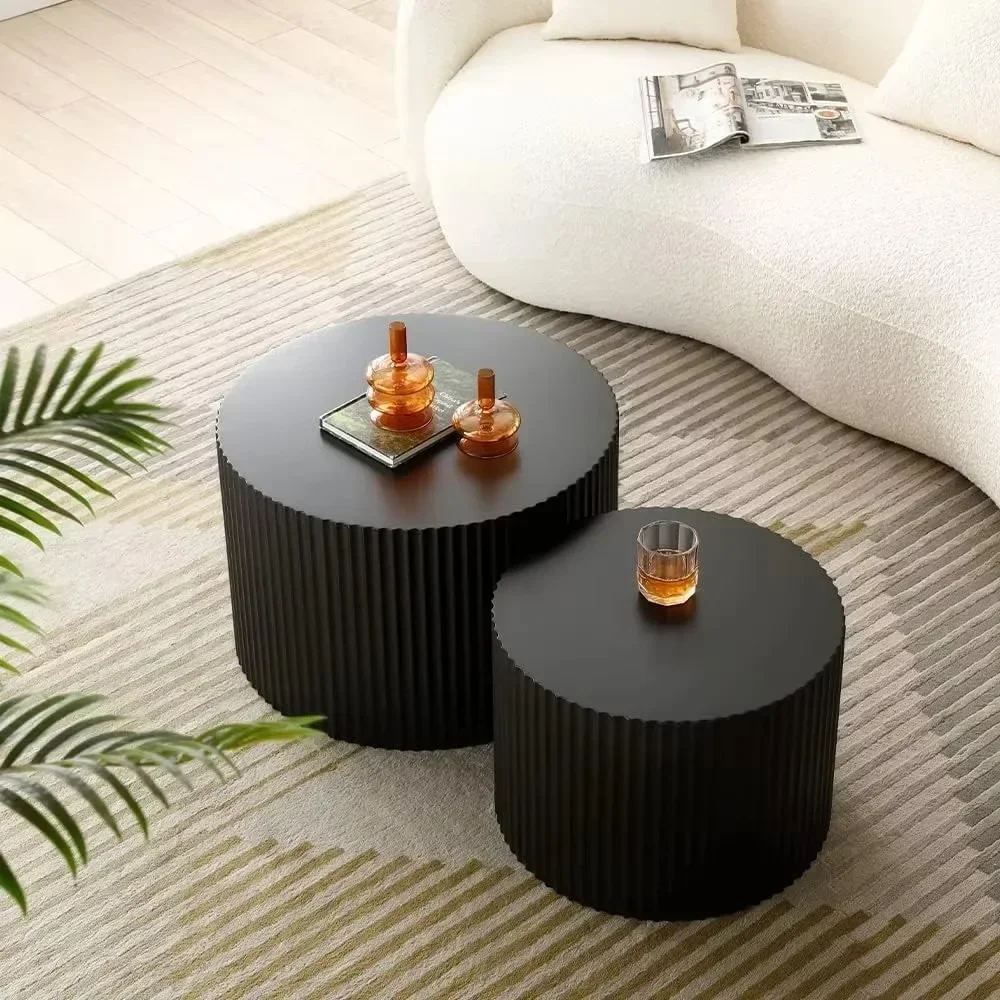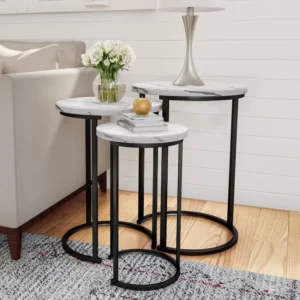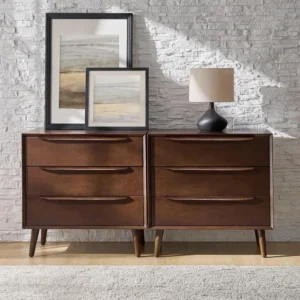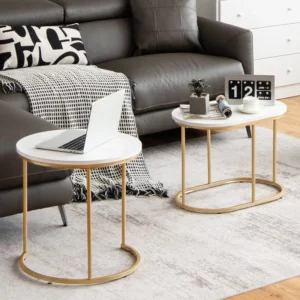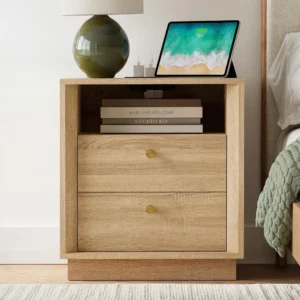Introduction
Nesting tables represent one of furniture design’s most ingenious space-saving solutions. These versatile pieces consist of two or more tables of varying sizes designed to tuck neatly beneath one another when not in use. When combined with the clean lines and organic forms of mid-century modern design, nesting table sets become not just functional pieces but artistic statements that transform living spaces.
The mid-century modern aesthetic emerged between the 1930s and 1960s, characterized by its emphasis on simplicity, functionality, and integration with nature. This design movement revolutionized how we think about home furnishings, prioritizing uncluttered spaces and forms that perfectly balance form and function.
Today, mid-century nesting tables remain remarkably popular because they bridge past and present effortlessly. Their timeless appeal complements contemporary interiors while providing authentic vintage character. These versatile pieces offer both practical advantages and artistic merit that few other furniture items can match.
In this comprehensive guide, we’ll explore the defining features of mid-century nesting tables, their space-saving benefits, selection criteria, styling possibilities, and proper care techniques. Whether you’re a mid-century enthusiast or simply appreciate space-saving nesting coffee tables with enduring appeal, you’ll discover everything needed to select and showcase these functional art pieces in your home. The popularity of mid-century modern nesting table sets continues to grow as more homeowners recognize their lasting value.
What Defines Mid-Century Modern Nesting Tables?
Mid-century modern design flourished from the 1930s through the 1960s, revolutionizing interior aesthetics with an emphasis on function, clean lines, and honest materials. This influential movement arose as designers sought to create accessible, beautiful furnishings for the average American home in the post-war era.
The hallmark principles that define mid-century modern nesting tables include:
- Functionality as the primary design driver
- Minimalist approach with elimination of unnecessary ornamentation
- Organic, flowing forms inspired by nature
- Truth to materials, showcasing authentic wood grains and textures
- Democratic design accessible to the average household
What makes mid-century nesting tables instantly recognizable is their perfect embodiment of these principles. They showcase practical space-saving design while maintaining visual lightness through tapered elements and thoughtful proportioning. Unlike heavily adorned traditional furniture, these tables let their materials and construction speak for themselves.
These tables exemplify the mid-century philosophy that beautiful objects should also be useful. Their ability to expand and contract as needed made them perfect for the smaller homes of the era while their sculptural qualities elevated them beyond mere utility. Today’s maximize small spaces nesting coffee tables continue this tradition of blending practicality with artistic merit.
Signature Leg Styles
The legs of mid-century nesting tables often serve as their most distinctive design element, instantly communicating their design heritage. These characteristic leg styles include:
- Tapered legs: Thicker at the top and gradually narrowing toward the floor, creating visual lightness and elegance
- Splayed legs: Angling outward from the table surface, providing stable support while creating dynamic visual tension
- Hairpin legs: Crafted from bent metal rods forming a triangular shape, offering minimal visual weight and industrial appeal
- Peg legs: Straight, cylindrical wooden legs that provide a clean, simple profile
- Compass legs: Legs that curve outward and then inward again, resembling a drawing compass
Each leg style contributes significantly to the table’s overall aesthetic impression. Tapered legs create a sense of upward movement, while splayed legs offer a playful geometric quality. The mid-century modern solid wood side end tables in our collection showcase these authentic leg styles that instantly communicate their design heritage.
Characteristic Materials and Finishes
Authentic mid-century modern nesting tables feature materials chosen for both beauty and function, with preferences for:
- Woods: Warm-toned hardwoods including:
- Teak: Prized for its rich color and natural oils that resist moisture
- Walnut: Celebrated for its deep, chocolate-brown tones and fine grain
- Oak: Valued for its durability and distinctive grain patterns
Rosewood: Admired for its dramatic striping and deep, rich colors
Metal accents: Strategic metal elements including:
- Brass: Providing warm golden tones that develop a distinctive patina
- Chrome: Offering sleek, reflective surfaces with industrial appeal
Copper: Contributing warm metallic highlights that age beautifully
Finishes: Treatments that enhance natural beauty:
- Oil finishes that penetrate wood to highlight grain
- Matte lacquers that protect without excessive shine
- Danish oil treatments that blend protection with natural appearance
Quality markers in authentic pieces include solid wood construction, dovetail or finger joints, and finishes that enhance rather than mask the natural material. Our mid-century modern walnut side end tables showcase these premium materials and attention to craftsmanship detail.
The Nesting Function: Form Meets Practicality
Mid-century nesting tables perfectly embody the era’s emphasis on practical design solutions that don’t sacrifice aesthetic appeal. Typically arranged in sets of two or three tables in graduating sizes, these pieces can be displayed as a single unit or separated to serve multiple functions throughout a room.
This ingenious space-saving design addressed the needs of growing families in modest post-war homes. When unexpected guests arrived, additional table surfaces could instantly appear without requiring permanent floor space. When not needed, they tucked neatly together, maintaining visual harmony.
The nesting mechanism itself represents thoughtful engineering, with precise proportions ensuring tables fit together seamlessly while maintaining their individual integrity. Table heights typically increase by 1-2 inches between pieces, with footprints that allow comfortable nesting without awkward overhangs.
Today’s homeowners appreciate these same space-optimizing benefits, making nesting tables space-saving solution particularly relevant for urban apartments and multifunctional rooms where flexibility matters most.
Why Mid-Century Nesting Tables Enhance Your Living Space
Mid-century nesting tables offer multiple compelling benefits that make them exceptional additions to contemporary interiors:
- Design versatility: Their clean, understated aesthetic complements diverse décor styles from minimalist to eclectic
- Functional flexibility: They transform from compact nested arrangement to multiple surfaces distributed throughout a space
- Space optimization: Perfect for apartments, small rooms, or anywhere that requires multifunctional furniture
- Investment quality: Well-crafted pieces maintain or increase their value while providing daily utility
These tables shine in scenarios that demand adaptability—serving as cocktail tables during gatherings, providing individual surfaces for several people working or dining, and creating layered display opportunities for treasured objects. Their modest footprint belies their outsized functionality.
Unlike bulky traditional coffee tables that permanently occupy significant floor space, nesting tables offer breathing room when tucked together yet expand to meet entertaining needs. This adaptability makes them particularly valuable in today’s homes where spaces often serve multiple purposes.
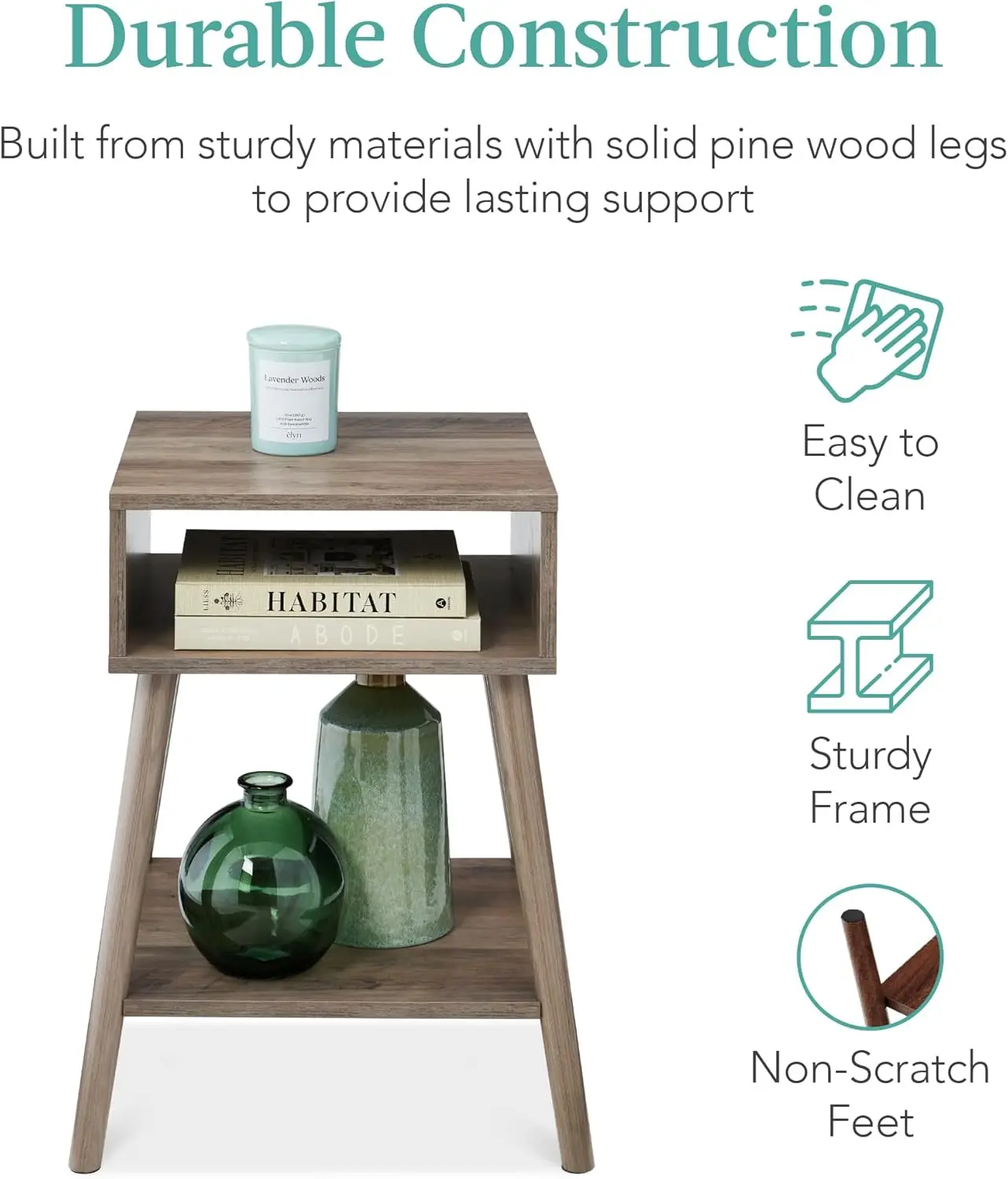
Our mid-century modern nesting side end tables collection showcases this perfect balance of form and function that has made these pieces enduringly popular.
Versatility Across Different Rooms
Mid-century nesting tables demonstrate remarkable adaptability throughout the home:
Living Room Applications:
– End tables flanking a sofa with the smaller table pulled out for drinks or books
– Coffee table alternative that can be separated when hosting guests
– Display surfaces for plants, art objects, or media components
Bedroom Possibilities:
– Nightstand with auxiliary surface for books, water carafe, or alarm clock
– Makeup or grooming station with cosmetics on different levels
– Reading nook companion providing space for books, lighting, and beverages
Home Office Setups:
– Laptop stand with separate surface for documents or reference materials
– Conference area with multiple work surfaces that store compactly
– Printer or equipment stand with expandable workspace
Entryway and Hallway Placement:
– Mail and key drop station that expands for sorting packages
– Plant display with varying heights for visual interest
– Guest welcome station with visitor essentials on separate surfaces
This versatility explains why various styles go well mid-century modern pieces, as they integrate seamlessly with diverse interior approaches while maintaining their distinctive character.
Space-Saving Solutions for Any Size Home
Nesting tables offer particularly compelling advantages in space-constrained environments:
In studio apartments or small urban dwellings, a nested set occupying just 20-24 inches square can replace a standard 48-inch coffee table, instantly freeing up valuable floor area. When entertaining, these compact units transform into multiple surfaces distributed strategically around the room.
For homeowners who entertain occasionally but don’t require permanent extra surfaces, nesting tables eliminate the need for storing folding tables. Their ability to expand table capacity when needed and contract when not makes them ideal for flexible living arrangements.
Strategic placement enhances their space-saving benefits—tucked partially under a sofa when nested, positioned in unused corners, or even serving as bedside tables in guest rooms that double as offices. Their mobility allows them to shift functions throughout the day.
Many homeowners unlock home entertaining nesting tables potential by distributing them during gatherings to ensure every guest has a convenient surface for drinks and appetizers, then nesting them afterward to maintain open traffic flow.
How to Select the Perfect Mid-Century Nesting Table Set
Finding the ideal mid-century nesting tables requires careful consideration of several key factors:
Space Assessment:
– Measure your available floor space precisely
– Consider traffic flow around the intended placement area
– Determine maximum table dimensions that won’t overwhelm the space
– Account for how tables will look both nested and separated
Authenticity Preferences:
– Decide whether vintage authenticity or modern interpretation matters more
– Consider how important original materials and construction methods are to you
– Determine if reproduction pieces with modern engineering might better suit your needs
– Reflect on whether patina and character marks add value or detract
Budget Considerations:
– Set a realistic budget range understanding quality impacts longevity
– Research typical price points across different sources (vintage dealers vs. reproductions)
– Consider long-term value rather than focusing solely on initial cost
– Factor in any restoration or maintenance needs for vintage pieces
Quality Evaluation:
– Examine joinery methods (dovetail and mortise-and-tenon indicate quality)
– Check stability and level surfaces on all component tables
– Assess wood quality and finish consistency
– Verify nesting mechanism functions smoothly and precisely
By systematically addressing these considerations, you’ll narrow your options to pieces that will truly satisfy both your aesthetic preferences and practical needs. For additional design inspiration, explore our guide on mastering mid-century nesting coffee tables that provides expert styling approaches.
Authentic Vintage vs. Modern Reproductions
When choosing mid-century nesting tables, the decision between authentic vintage pieces and modern reproductions presents distinct advantages and considerations:
Authentic Vintage Pieces:
– Pros:
– Genuine historical significance and craftsmanship
– Unique character with natural patina developed over decades
– Often feature solid hardwoods throughout construction
– Potential investment value that appreciates over time
– Cons:
– Generally higher price points ($800-2,500+ for quality sets)
– May require restoration or refinishing
– Dimensions sometimes smaller than contemporary preferences
– Limited availability of matching pieces
Modern Reproductions:
– Pros:
– More accessible price points ($300-1,200 for quality reproductions)
– Contemporary construction standards for stability
– Consistent finishes without damage or wear
– Availability of matching pieces within collections
– Cons:
– Lack historical significance and authentic patina
– May use veneers rather than solid woods throughout
– Variable quality across manufacturers
– Limited appreciation potential compared to vintage pieces
Identifying authentic vintage pieces involves examining construction techniques (hand-cut dovetail joints), materials (solid woods rather than particleboard), and hardware (original brass or steel components). Look for manufacturer labels, which often appear as stamps or metal plates on drawer undersides or table bottoms.
Our mid-century modern vintage side end tables collection offers pieces that capture authentic period design details while ensuring modern quality standards.
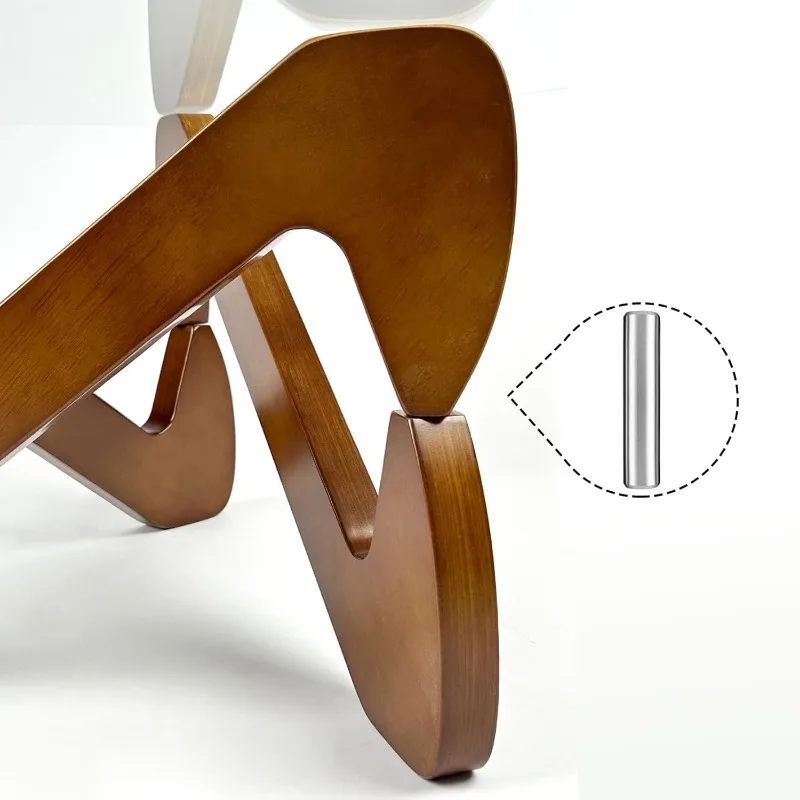
Essential Measurements and Space Planning
Understanding standard dimensions helps ensure your mid-century nesting tables will fit comfortably in your space:
Typical Measurements:
– Small table: 16-18 inches wide/deep × 16-18 inches tall
– Medium table: 18-20 inches wide/deep × 18-20 inches tall
– Large table: 20-24 inches wide/deep × 20-22 inches tall
When measuring your space, consider:
– Allow 18-24 inches between tables and seating for comfortable reach
– Ensure at least 30 inches of walking space around table arrangements
– Match table height to nearby seating (tables should be 1-2 inches lower than chair/sofa arms)
– Consider scale with existing furniture—tables should visually balance with surrounding pieces
For accurate space planning, create paper templates of each table’s footprint to test different arrangements before committing. Remember that nesting tables require clear floor space both when nested and when fully deployed for maximum functionality.
Materials and Construction Quality Markers
Identifying quality construction in mid-century nesting tables involves examining several key indicators:
Wood Quality Assessment:
– Solid wood components will have consistent grain patterns throughout
– Quality veneers should be thick enough to resist chipping (at least 1/16 inch)
– Wood should feel substantial and dense rather than lightweight
– Grain matching on veneer indicates attention to detail
Superior Joinery Techniques:
– Dovetail joints at corners suggest premium craftsmanship
– Mortise-and-tenon construction for leg attachment ensures durability
– Finger joints show thoughtful engineering at stress points
– Visible joinery should fit precisely without gaps
Hardware Elements:
– Brass or steel hardware suggests quality construction
– Smooth-operating mechanisms for any moving parts
– Consistent finishes on all metal components
– Securely attached hardware without wiggle or play
Surface Finish Evaluation:
– Even application without drips or bubbles
– Smooth transitions between surfaces
– Protection on all surfaces including undersides
– Consistent sheen across all component tables
These quality indicators signify furniture built to last generations rather than years, making the investment in superior pieces worthwhile for both daily use and long-term value.
Distinctive Mid-Century Nesting Table Styles
Mid-century nesting tables encompass diverse design approaches that reflect their geographic origins and designers’ unique perspectives. This diversity offers options for virtually any interior aesthetic preference:
Regional Design Movements:
– Scandinavian designs emphasizing lightness and natural materials
– American interpretations featuring bolder proportions and statement pieces
– Italian approaches incorporating glass and innovative materials
– British designs balancing tradition with modernism
Chronological Evolution:
– Early mid-century (1940s): Transitional features with some traditional elements
– Classic period (1950s): Perfected balance of form and function
– Late mid-century (1960s): More experimental forms and material combinations
– Revival pieces: Contemporary interpretations of classic principles
Complementary Interior Styles:
– Minimalist settings highlighting clean lines and geometric precision
– Bohemian spaces appreciating organic forms and natural materials
– Contemporary interiors valuing functional art and statement pieces
– Eclectic rooms benefiting from versatile, adaptable furnishings
Each style category offers unique advantages for different spaces and preferences. Our mid-century modern Danish coffee tables collection showcases the Scandinavian influence that has particularly endured in contemporary interior design.
Scandinavian Simplicity
Scandinavian mid-century nesting tables represent perhaps the most enduring and widely appreciated expression of the style, characterized by:
Material Preferences:
– Teak as the signature wood, prized for its warm tones and natural oils
– Lighter woods like oak and birch creating airy, luminous qualities
– Minimal metal accents, typically in brushed rather than polished finishes
– Natural wool or leather touchpoints where applicable
Design Characteristics:
– Exceptionally clean lines without unnecessary embellishment
– Gently rounded edges softening geometric forms
– Tapered legs that create visual lightness
– Emphasis on perfect proportions rather than decorative elements
Notable Designers:
– Hans Wegner’s organic interpretations of functional forms
– Finn Juhl’s sculptural approach to everyday objects
– Børge Mogensen’s focus on democratic design accessibility
– Arne Jacobsen’s architectural approach to furniture design
The Scandinavian approach emphasizes furniture as practical sculpture—pieces that perform their function flawlessly while contributing beauty through their honest materials and thoughtful proportions rather than applied decoration.
American Mid-Century Innovation
American designers brought distinct energy to mid-century nesting tables, often featuring:
Material Preferences:
– Walnut as the predominant wood, celebrated for its rich, chocolate tones
– Bolder mixing of materials including metal, glass, and engineered surfaces
– More prominent hardware as design features rather than hidden necessities
– Experimental uses of new manufacturing techniques and materials
Design Characteristics:
– More substantial proportions than Scandinavian counterparts
– Dramatic geometric forms making stronger statements
– Increased contrast between elements (light/dark, natural/manufactured)
– Integration of technological advancements in materials and construction
Regional Variations:
– West Coast designs embracing organic influences and indoor-outdoor living
– East Coast approaches maintaining connections to European traditions
– Midwest manufacturers focusing on production efficiency and accessibility
– Southern interpretations incorporating regional woods and craftsmanship
American mid-century pieces often serve as focal points rather than blending seamlessly into interiors, making them ideal for those who want furniture that sparks conversation while remaining functional.
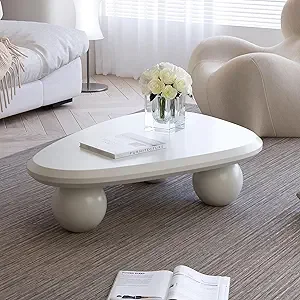
Metal and Wood Combinations
The marriage of metal and wood represents one of mid-century design’s most distinctive and enduring contributions to furniture design:
Popular Combinations:
– Walnut with brass accents creating warm, rich pairings
– Teak with stainless steel for contrast between warm and cool tones
– Oak with blackened steel offering dramatic visual tension
– Rosewood with chrome details for sophisticated elegance
Industrial Influences:
– Manufacturing advances allowing new metal forming techniques
– Post-war material availability expanding design possibilities
– Machine aesthetic celebrating rather than concealing construction methods
– Interest in expressing modern technological progress through furniture
Metal Finishing Techniques:
– Brushed surfaces creating subtle light play without high shine
– Patinated finishes developing character over time
– Powder-coating for durability and consistent color application
– Polished elements for strategic highlights and reflectivity
These material combinations create visual interest through contrast while celebrating the unique properties of each component. The tension between organic wood grain and precise metal elements exemplifies mid-century design’s balanced approach to natural and manufactured materials.
Expert Styling Tips for Mid-Century Nesting Tables
Successfully integrating mid-century nesting tables into your interior requires thoughtful styling approaches that honor their design heritage while meeting your functional needs:
Fundamental Styling Principles:
– Respect negative space around tables rather than crowding them
– Balance organic elements (plants, ceramics) with geometric accessories
– Maintain visual lightness by avoiding overcrowding surfaces
– Create intentional groupings rather than random object collections
Functional Balance:
– Designate specific roles for each table (display, serving, storage)
– Consider how tables will function both nested and separated
– Ensure easy access to frequently used items
– Plan for flexibility as needs change throughout the day
Cohesive Integration:
– Echo table materials elsewhere in the room (wood tones, metal finishes)
– Align table proportions with surrounding furniture scale
– Use tables to bridge different design elements within a space
– Allow distinctive table features to inspire other décor choices
Common Styling Mistakes to Avoid:
– Placing oversized objects that overwhelm table proportions
– Creating unstable arrangements that risk toppling
– Blocking the nesting function with permanent displays
– Competing with the tables’ inherent beauty through excessive styling
For additional inspiration, our guide to best compact mid-century coffee tables offers complementary styling ideas that work particularly well in smaller spaces.
Creating Visual Balance in Different Room Settings
Adapting mid-century nesting tables to various room settings requires thoughtful placement strategies:
Living Room Arrangements:
– Position nested tables where they can easily be separated when needed
– Consider asymmetrical placement rather than centering for visual interest
– Use tables to create conversation zones within larger spaces
– Layer tables with different heights to create dimensional interest
Bedroom Applications:
– Place a complete set beside the bed with the smallest table pulled out for nighttime essentials
– Position a single table from the set as a minimalist nightstand
– Use separated tables to create a morning coffee station and reading nook
– Create a dressing table arrangement with cosmetics or accessories organized by table
Entryway Staging:
– Nest tables against a wall with a mirror above for last-minute checks
– Separate tables to create distinct zones for keys, mail, and seasonal items
– Use varying heights to create visual rhythm in narrow hallways
– Position tables to facilitate daily routines like bag-dropping and shoe removal
Office Integration:
– Create an expandable work surface that adapts to different projects
– Establish separate zones for technology, reference materials, and personal items
– Use tables as mobile surfaces that follow your workflow throughout the day
– Design a conference area that expands or contracts based on meeting size
Mid-Century Modern Danish Coffee Tables, Mid-Century Modern Oval Coffee Tables, Mid-Century Modern Solid Wood Coffee Tables
$390.05 Select options This product has multiple variants. The options may be chosen on the product pageMid-Century Modern Nesting Side & End Tables, Mid-Century Modern Nesting Table Sets, Mid-Century Modern Round Side & End Tables
Price range: $239.35 through $273.06 Select options This product has multiple variants. The options may be chosen on the product pageMid-Century Modern End Table Sets of 2, Mid-Century Modern Walnut Side & End Tables
Price range: $978.89 through $1,957.38 Select options This product has multiple variants. The options may be chosen on the product pageMid-Century Modern Glass Top Coffee Tables, Mid-Century Modern Vintage Coffee Tables, Mid-Century Modern Vintage Side & End Tables
$725.36 Select options This product has multiple variants. The options may be chosen on the product pageMid-Century Modern Nesting Coffee Tables, Mid-Century Modern Nesting Table Sets
$361.45 Select options This product has multiple variants. The options may be chosen on the product pageMid-Century Modern Solid Wood Side & End Tables, Mid-Century Modern Vintage Side & End Tables
Price range: $347.99 through $376.99 Select options This product has multiple variants. The options may be chosen on the product page
Accessorizing Your Nesting Tables
The right accessories enhance mid-century nesting tables without overwhelming their elegant simplicity:
Scale-Appropriate Decorative Elements:
– Low-profile books or magazines that won’t topple
– Small sculptural objects that complement table proportions
– Ceramic vessels with clean, simple lines
– Modest table lamps with balanced proportions
Functional Accessories:
– Coasters that protect surfaces while adding visual interest
– Small trays that corral remote controls or personal items
– Modest storage boxes for everyday essentials
– Compact table clocks with period-appropriate styling
Era-Compatible Styling Elements:
– Geometric patterns that echo mid-century design motifs
– Natural elements like small houseplants or stone objects
– Handcrafted ceramic pieces with organic forms
– Abstract art pieces in complementary color palettes
Layering Techniques:
– Create height variation with objects of different scales
– Overlap elements selectively for dimensional interest
– Group items in odd numbers for visual appeal
– Use negative space intentionally between objects
Remember that mid-century design celebrates “less is more”—allow the tables themselves to shine rather than concealing their beauty beneath too many accessories.
Proper Care for Mid-Century Nesting Tables
Maintaining the beauty and structural integrity of mid-century nesting tables requires appropriate care routines:
General Maintenance Guidelines:
– Dust regularly with a soft, lint-free cloth
– Keep tables away from direct sunlight to prevent fading
– Maintain consistent humidity levels to prevent wood expansion and contraction
– Use coasters and mats to protect surfaces from moisture and heat
– Lift rather than drag objects across surfaces to prevent scratches
Wood-Specific Care:
– Clean with mild soap and water, drying immediately
– Apply appropriate wood conditioner annually based on finish type
– Address dry wood with mineral oil or beeswax-based products
– Test all products on an inconspicuous area first
Metal Component Maintenance:
– Clean brass with specific brass cleaners or lemon juice/baking soda paste
– Maintain chrome with glass cleaner and soft cloth
– Remove fingerprints from stainless steel with diluted vinegar solution
– Apply appropriate metal protectants to prevent tarnishing
Damage Prevention:
– Use felt pads under all items placed on tables
– Avoid placing hot items directly on wood surfaces
– Keep tables away from heating vents and radiators
– Address spills immediately to prevent staining
With proper care, quality mid-century nesting tables can maintain their beauty and functionality for generations, making them true investment pieces.
Routine Maintenance Guidelines
Establishing a regular care routine ensures your mid-century nesting tables remain in excellent condition:
Weekly Care:
– Dust with a soft microfiber cloth, following the wood grain
– Wipe metal components with appropriate cleaner
– Check for any developing issues like loose joints
– Remove and clean under decorative objects to prevent dust accumulation
Monthly Attention:
– Perform deeper cleaning with appropriate wood cleaner
– Polish metal elements to maintain luster
– Inspect joinery and hardware for any needed tightening
– Rotate placement if tables receive uneven sun exposure
Seasonal Maintenance:
– Apply wood conditioner appropriate for your finish (oil, wax, or polish)
– Check humidity levels in your home and adjust as needed
– Thoroughly clean underneath and between nested tables
– Inspect for any developing issues requiring professional attention
Preventative Measures:
– Use appropriately sized felt pads under all items
– Apply quality furniture wax every 6-12 months as a protective barrier
– Consider UV-filtering window treatments if tables are near windows
– Keep hand lotions and alcohol-based products away from wood surfaces
Consistent routine care prevents most serious issues and maintains the beauty of your tables with minimal effort.
Addressing Common Issues and Repairs
Even well-maintained mid-century nesting tables may develop issues over time that require specific remedies:
Surface Scratches:
– For oil finishes: Apply matching oil to the affected area, allowing it to penetrate
– For lacquered surfaces: Use a matching color touch-up marker followed by clear polish
– For deep scratches: Fill with wood putty, sand smooth, and refinish to match
– For veneer: Consult a professional as DIY repairs can worsen damage
Water Rings or Heat Marks:
– Minor marks: Try mayonnaise or petroleum jelly left overnight, then wipe clean
– White marks: Gently rub with fine steel wool and lemon oil
– Persistent marks: Create a paste with baking soda and water, apply briefly then clean
– Severe damage: May require professional refinishing of the affected surface
Structural Concerns:
– Loose joints: Apply wood glue to the joint, clamp until dry
– Wobbly legs: Tighten hardware or reinforce with appropriate wood glue
– Split wood: Address with wood glue and clamps, followed by touch-up finishing
– Veneer lifting: Use wood glue applied with a syringe, press flat until dry
When to Seek Professional Help:
– Extensive refinishing needs
– Structural repairs affecting table stability
– Veneer replacement or major repairs
– Antique pieces with significant historical value
For valuable vintage pieces, investing in professional restoration often proves more economical than attempting complex repairs yourself and potentially decreasing the item’s value.
Where to Find Quality Mid-Century Nesting Tables
Finding exceptional mid-century nesting tables requires knowing where to look and what questions to ask:
Purchasing Channels:
– Specialized vintage furniture dealers with expertise in mid-century pieces
– Curated online marketplaces focusing on authenticated vintage items
– Estate sales in neighborhoods developed during the mid-century period
– Reputable reproduction manufacturers with proven quality standards
– Auction houses for investment-quality designer pieces
Price Expectations:
– Authentic vintage pieces from unknown makers: $400-800
– Designer-attributed vintage sets in good condition: $800-2,500+
– Quality reproductions with solid wood construction: $300-1,200
– Budget reproductions with veneer construction: $150-400
– Restoration-needed vintage pieces: $200-500 (plus restoration costs)
Evaluating Seller Reputation:
– Research return policies and satisfaction guarantees
– Check reviews specifically mentioning furniture condition accuracy
– Verify authentication processes for vintage pieces
– Assess transparency regarding materials and construction methods
– Confirm delivery methods appropriate for fragile vintage items
Essential Questions Before Purchasing:
– Is this authentic vintage or a reproduction?
– What materials compose the entire piece (not just visible surfaces)?
– Has the piece been restored or refinished?
– Are there any structural issues I should know about?
– What is the exact dimension of each table in the set?
– How do the tables nest together? Is the mechanism original?
Taking time to research thoroughly before purchasing ensures you’ll acquire tables that meet your quality expectations and provide lasting value.
FAQ About Mid-Century Modern Nesting Tables
What price range should I expect for authentic mid-century nesting tables?
Authentic vintage mid-century nesting tables typically range from $400-800 for unsigned pieces in good condition, while designer-attributed sets from notable makers can command $800-2,500 or more depending on condition, provenance, and rarity.
How can I verify if my nesting tables are genuinely from the mid-century period?
Look for construction techniques like dovetail joints, mortise-and-tenon connections, and original hardware. Examine the wood for appropriate aging and patina. Check for maker’s marks on the underside or inside drawers. The overall proportions and materials should align with mid-century aesthetics—tapered legs, clean lines, and hardwoods like teak, walnut, or rosewood.
Can mid-century nesting tables work with traditional décor styles?
Yes, mid-century nesting tables often serve as excellent “bridge pieces” in transitional interiors. Their clean lines and natural materials complement traditional elements while introducing subtle contemporary influence. Choose tables with warm wood tones rather than stark contrasts for the most harmonious integration with traditional furnishings.
Do authentic mid-century nesting tables increase in value over time?
Well-maintained pieces by recognized designers or manufacturers typically appreciate modestly over time, though they shouldn’t be viewed primarily as investments. Tables with documented provenance, original finishes, and distinctive design features generally hold value better than unsigned or heavily restored pieces.
What are standard dimensions for mid-century nesting table sets?
Most mid-century nesting sets include 2-3 tables with the largest typically measuring 20-24 inches wide and 18-22 inches tall. Each subsequent table reduces in size by approximately 2-4 inches in width and 1-2 inches in height. These proportions allow comfortable nesting while maintaining functional surface areas.
Are Mid-Century Nesting Tables Worth the Investment?
Mid-century nesting tables represent exceptional value compared to many contemporary furniture options:
Durability Considerations:
Mid-century tables were generally built with higher construction standards than many mass-market contemporary pieces. Solid wood construction, precision joinery, and quality hardware contribute to lifespans measured in decades rather than years. This longevity translates to lower cost-per-use compared to cheaper alternatives requiring frequent replacement.
Aesthetic Longevity:
The clean, organic lines of mid-century design have demonstrated remarkable staying power over 70+ years. Unlike trendy furniture that quickly appears dated, these classic pieces integrate seamlessly with evolving décor styles. This design longevity means you won’t feel pressured to replace them as other interior elements change.
Resale Potential:
Quality mid-century pieces generally maintain strong resale value when properly cared for. While not guaranteed to appreciate dramatically, they typically hold value better than contemporary mass-market furniture, which often depreciates rapidly after purchase. This resale strength provides financial flexibility if your needs or preferences change.
Practical Value Analysis:
When calculating true cost, consider longevity and versatility alongside initial price. A $600 mid-century nesting set that serves multiple functions and lasts 30+ years represents better value than a $300 contemporary set requiring replacement within 5-10 years. The superior materials and construction quality directly translate to extended useful lifespan.
How Do Mid-Century Nesting Tables Compare to Other Table Styles?
Understanding how mid-century nesting tables compare to alternatives helps determine if they’re the right choice for your specific needs:
Functional Comparison:
Unlike fixed coffee tables that permanently occupy floor space, nesting tables provide adaptable surface area that expands or contracts as needed. Compared to folding tables, they offer superior aesthetics and sturdier construction. Against modular systems, they provide simpler operation without complex mechanisms that can fail over time.
Aesthetic Comparison:
Mid-century nesting tables offer cleaner lines than traditional styles with their ornate details and heavier proportions. Compared to ultra-contemporary pieces, they provide warmer materials and organic elements that prevent spaces from feeling cold or sterile. Their balanced approach to form and function bridges these extremes effectively.
Versatility Assessment:
Few furniture pieces match the multi-room adaptability of nesting tables. Traditional side tables serve fixed purposes in predetermined locations, while contemporary modular pieces often work only in specific settings. Mid-century nesting tables transition seamlessly between formal living areas, casual family spaces, bedrooms, and offices.
Investment Comparison:
Quality mid-century nesting tables typically represent better long-term value than both budget contemporary alternatives (which lack durability) and high-end traditional pieces (which command premium prices but offer less flexibility). Their enduring design relevance and quality construction create lasting utility that justifies their moderate price point.
The compelling combination of versatility, space efficiency, timeless design, and quality construction explains why mid-century nesting tables remain exceptional additions to today’s homes, just as they were when first introduced over half a century ago.

